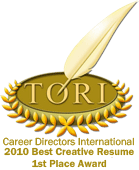 The bad news about applying for advertised positions is that many of them don’t actually exist. Many online job postings are from companies THINKING about hiring, work-at-home schemes, insurance sales, or worse – phishing trips and scams. In fact, your chances of landing a position advertised online is about 3 percent.
The bad news about applying for advertised positions is that many of them don’t actually exist. Many online job postings are from companies THINKING about hiring, work-at-home schemes, insurance sales, or worse – phishing trips and scams. In fact, your chances of landing a position advertised online is about 3 percent.
The good news is you can also use your resume to apply for unadvertised positions, which make up about 80% of the open positions in the job market. This involves researching companies you’d like to work for, finding a contact at the company (again, using LinkedIn and Glassdoor as mentioned in a previous post), and sending your resume with an introductory letter outlining why you’d like to work for the company. When you have a clear picture of the type of position you want — and the company you’d like to work for — it gives you a real direction for your job search. You know who to target and where to apply, and if you’re approaching a company that isn’t currently advertising an opening, you’re also not competing with dozens — or hundreds, or thousands — of other jobseekers.
If you don’t already have a list of your “dream employers,” you can compile one by asking yourself the following questions:
- What industry is my target employer in?
- What kind of company do I want to work for? (public, private, nonprofit? Startup or well-established company?)
- Do I want to work for a small company, a larger employer — or somewhere in between? (Identify size by number of employees – 1 to 20, 21 to 50, 51-100, more than 100, more than 500?)
- Ownership structure: Do I want to work for a family-owned company? A sole proprietorship? A multinational company with an international parent company? A franchise? A company with a centralized ownership group? A corporate entity?
- Where do I want to work (geographic preferences — like a particular city or state, or even companies within a certain proximity to your home). Do I want to work for a company that offers telecommuting, so it doesn’t matter where I live in relation to where the company is located?
- What about company culture? (An organization’s culture is defined as “widely shared values that provide unity and cooperation to achieve common goals.”) What is important to me in terms of the company’s mission, commitment to employees, sense of fun, emphasis on learning, leadership style, systems and processes, recruiting/hiring methodology, etc.
Next, clarify your ideal job — what is the position you’d most like to have?
- What are possible job titles for the type of position I want? (The same position might have different names at different companies; the more job titles you can identify for the type of work you want to do, the easier it will be for you to research your dream opportunity.)
- What is a typical day like in your ideal position? Would it involve meetings? Would you be working independently on projects, as part of a team, or both? Would they be short-term projects, or long-term projects?
- What type of reporting structure would you prefer? Who would you report to? Who would report to you?
- How much would you be making in this position? Compensation can be an important consideration. Don’t just identify a target salary — remember that benefits and other non-cash compensation are part of the total package.
Armed with the information you’ve distilled about your ideal job and your ideal company, you can go about finding possible opportunities.
Research image courtesy Stuart Miles and green check image courtesy yodiyim via FreeDigitalPhotos.net.








